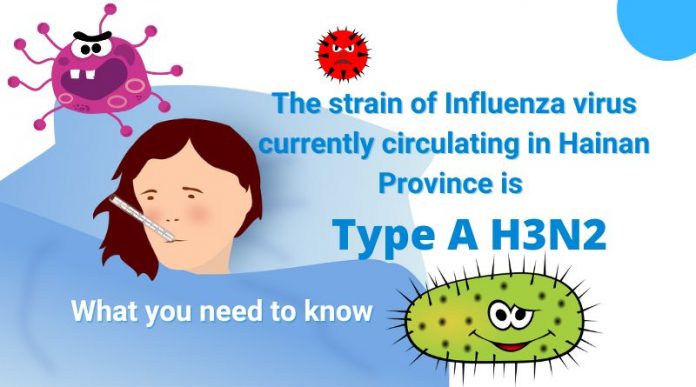Its flu season, the strain of Influenza virus currently circulating in Hainan Province is type A H3N2.
Influenza A (H3N2) is a respiratory disease caused by the influenza A (H3N2) virus, which can be transmitted through the respiratory tract. Most patients show symptoms with common influenza, but in certain cases it may also lead to death.
Influenza virus can induce a cytokine storm (life-threatening systemic inflammatory syndromes involving elevated levels of circulating cytokines and immune-cell hyperactivation) and systemic inflammatory response, which can lead to respiratory distress syndrome (ARS), shock, encephalopathy (damage or disease that affects the brain) and multiple organ dysfunction and other complications.
Differential diagnosis (a list of possible conditions that share the same symptoms) of influenza and the common cold is particularly important.
The flu is usually more severe and has more complications. The degree of fever in children is usually higher than that in adults, and gastrointestinal symptoms such as nausea, vomiting, abdominal pain, and diarrhoea are also more common when suffering from influenza than in adults; for those without complications the fever gradually subsides at around 3 to 4 days after the onset of the infection.
pneumonia
Primary influenza virus pneumonia
Secondary bacterial pneumonia
Mixed viral and bacterial pneumonia
Nervous system damage
Including encephalitis (inflammation of the brain), meningitis, acute necrotizing encephalopathy, myelitis, Guillain-Barre syndrome, etc.
Heart damage
Common complications included myocarditis and pericarditis
The main clinical manifestations are elevated creatine kinase and abnormal electrocardiogram. Severe cases may have heart failure. In addition, influenza virus infections significantly increases the risk of myocardial infarction, ischemic heart disease-related hospitalization and even death.
Detection and diagnosis of influenza
Laboratory etiological examination of febrile patients:
Viral nucleic acid detection is currently the gold standard for diagnosis due to its strong specificity and high sensitivity, and can distinguish virus types and subtypes. Rapid antigen detection can help medical institutions for infection control in hospitals and the initial screening of a large number of suspected cases during influenza outbreaks.
High-risk groups for severe cases of influenza
- Weak immunity, susceptible to influenza virus.
- Patients with underlying cardiopulmonary diseases, causing serious complications such as pneumonia.
- Influenza viruses damage the body’s structure, triggering inflammation and aggravating the underlying disease.
The ability to clear the virus is weak, the detoxification time is long, and it is easy to spread the virus. Influenza symptoms last longer and are more severe in high-risk groups.
Home isolation of non-hospitalized patients
Keep the room ventilated. Get plenty of rest, drink plenty of water, and eat an easily digestible and nutritious diet. Closely observe changes in your condition, especially in children and elderly patients.
Get antivirals as soon as possible
People at high risk of influenza virus infection are prone to severe influenza. Early antiviral treatment can reduce influenza symptoms, shorten the course of influenza, and reduce the fatality rate of severe influenza.
Children should avoid salicylic acid preparations
Children should not use aspirin or aspirin-containing medicines and other salicylic acid preparations.
Hospitalization for those who meet the criteria
Inpatient treatment criteria (meeting one or more of the following criteria): women in the second and third trimesters; where underlying diseases are significantly aggravated, such as: chronic obstructive pulmonary disease, diabetes, chronic cardiac insufficiency, chronic renal insufficiency, liver cirrhosis, etc.; meet the diagnostic criteria for severe or critical influenza; associated with organ dysfunction.
Avoid blind or inappropriate use of antimicrobials
Avoid blind or inappropriate use of antibiotics. Antibiotics are indicated only when influenza is secondary to bacterial pneumonia, otitis media (an infection of the middle ear), and sinusitis (sinuses are inflamed).
Pre-treatment, focus on prevention
Vaccination
Vaccination is the most effective way to prevent influenza. It is recommended for key groups such as the elderly over 60 years old, children between 6 months and 5 years old, pregnant women, family members and caregivers of children under 6 months old, chronic disease patients and medical staff to get a flu shot.
Drug prophylaxis (a prophylactic drug is one that’s used to prevent a disease or condition)
Pharmacological prophylaxis is not a substitute for vaccination. Post-exposure prophylaxis is recommended for close contacts with high-risk factors for severe influenza, not later than 48 hours after exposure. Oseltamivir or zanamivir can be used (the dose is the same as the therapeutic amount, once a day for 7 days).
General Prevention
- wash hands frequently;
- keep the environment clean and ventilated;
- Minimise activities in crowded places and avoid contact with patients with respiratory infections;
- When coughing or sneezing, cover your mouth and nose with your upper arm or a tissue, towel, etc., and try to avoid touching your eyes, nose or mouth;
- If you have flu-like symptoms, you should pay attention to rest and self-isolation, and wear a mask when going to public places or seeking medical treatment.
Related article: Haikou opens 28 temporary clinics for influenza patients








